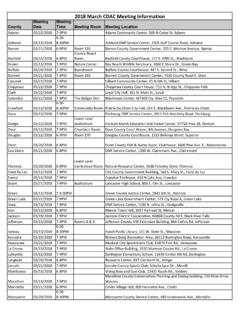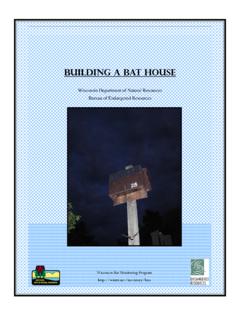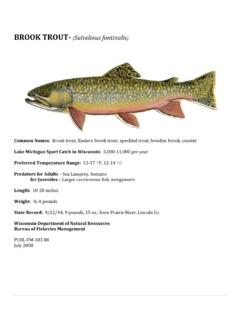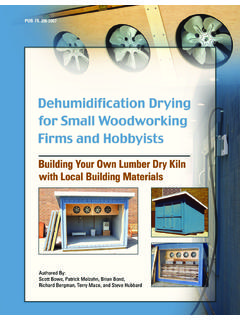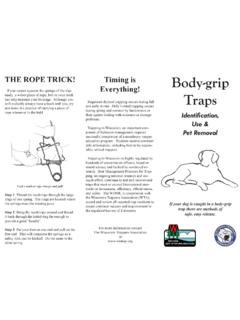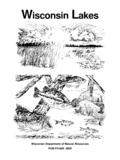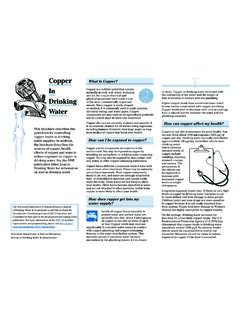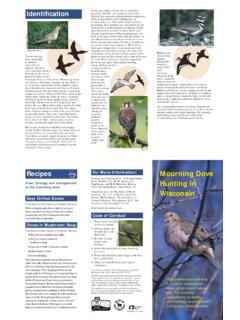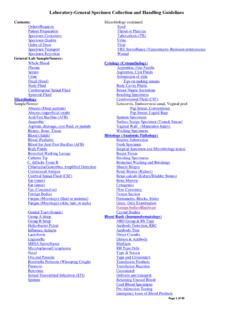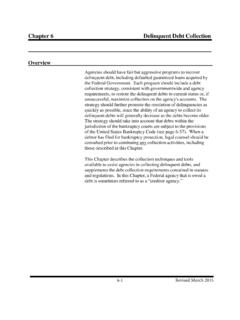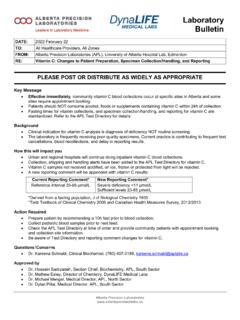Transcription of “RCRA empty” determinations - Wisconsin Department of ...
1 DNR Waste & Materials Management Program Revised 2021 PUB-WA-1784 aerosol Can Management Guidance on Hazardous Waste Requirements Introduction aerosol spray cans contain products and propellants under pressure that can be dispensed as spray, mist or foam. Common products include insecticides, cooking sprays, solvents and paints. Most aerosol cans are made of recyclable steel or aluminum and can be easily managed as scrap metal when empty. However, when aerosol cans are unusable or cannot be emptied due to defective or broken spray nozzles the remaining liquids, vapors, or even the can itself, may be hazardous waste and subject to regulation.
2 Waste aerosol cans cannot be managed as universal waste in Wisconsin . While the Environmental Protection Agency and some states allow aerosol cans to be managed as universal waste this regulatory allowance has not been adopted in Wisconsin at this time and aerosol cans continue to require waste determinations and proper management. This publication provides waste management guidance to businesses generating hazardous waste aerosol cans. The following sections will define and discuss the Resource Conservation and Recovery Act RCRA empty determinations , acute hazardous waste determinations , storage requirements, puncturing requirements and hazardous waste reduction recommendations.
3 RCRA empty determinations The first step to determine management requirements is to evaluate whether the waste aerosol cans are RCRA empty according to s. NR , Wis. Adm. Code, and the EPA s RCRA definition of empty containers. Waste aerosol cans are RCRA empty when they meet all criteria listed below: 1. The aerosol cans must contain no compressed propellant ( , the aerosol cans release no pressure through an open, working valve). [s. NR (2)(b), Wis. Adm. Code] 2. All chemical product that can be dispensed through the valve has been dispensed ( , the aerosol can no longer sprays any product through an open, working valve).
4 [s. NR (2)(a)1, Wis. Adm. Code] 3. No more than 3% of the original capacity/net weight of the full container or no more than 1 inch of liquid residue remains in the aerosol can. [s. NR (2)(a)2 and (3)(a), Wis. Adm. Code] If an aerosol can contained non-pharmaceutical acute hazardous waste (P- listed or F027) it must be punctured and triple rinsed using a solvent capable of removing the commercial chemical product. Hazardous waste regulations are found in chapters NR 600-679 of the Wisconsin Administrative Code. Do NOT discharge non-empty waste aerosol cans into the air to empty the cans. The uncontrolled release of hazardous waste and containerized propellants ( , butane, propane) into the atmosphere from the aerosol cans constitutes disposal of hazardous waste.
5 All generated hazardous waste must be transported, treated, stored or disposed of at licensed facilities. [s. NR (26), Wis. Adm. Code; s. and s. (9), Wis. Stats.] PUB-WA-1784 2021 Page 2 of 6 The solvent rinse must be managed as acute hazardous waste, it will count toward monthly generation totals, and if mixed with other residuals, the entire contents of the container must be managed as acute hazardous waste. Special care should be taken when managing aerosol cans with acute hazardous wastes. [s. NR (2)(c)1, Wis. Adm. Code] Once the waste aerosol can is RCRA empty, and has been triple rinsed if required, it is considered scrap metal and can be collected for recycling.
6 While not a Wisconsin Department of Natural Resources requirement, the scrap metal marketer may require the RCRA empty waste aerosol cans to be punctured to confirm that they are empty. Hazardous waste aerosol cans An aerosol spray can is a waste when it can no longer be used for its intended purpose. This typically does not include defective products returned to the retailer or manufacturer for refund or replacement. A small percentage of aerosol cans may not contain hazardous materials; however, the majority consist of contents under pressure that are flammable. The handling of these hazardous waste aerosol cans can pose risks to workers and the environment.
7 The following diagram is a general representation of the management options and requirements for hazardous waste aerosol cans. As indicated in the diagram below, there are two options for managing hazardous waste aerosol cans: Containerize and label as hazardous waste and ship off-site to a licensed treatment, storage and disposal (TSD) facility. List s of licensed hazardous waste transporters and licensed hazardous waste TSD facilities are available by going to and searching waste facility. Collect the cans and manage them within the requirements and guidelines described in this document. If an aerosol can held acute or non-acute hazardous waste pharmaceuticals, it must be managed as a non-creditable hazardous waste pharmaceutical, no matter how little residue remains.
8 [s. NR (4), Wis. Adm. Code] PUB-WA-1784 2021 Page 3 of 6 Acute hazardous waste determination A hazardous waste aerosol can is an acute hazardous waste if the contents contain a P-listed commercial chemical product, identified in ss. NR (5) or (6), Wis. Adm. Code, or if the contents contain a F027 listed waste from the table in s. NR (1). As acute hazardous wastes pose serious health and environmental hazards it may be safer, less expensive and easier to dispose of the can and residual contents as acute hazardous waste rather than puncturing and rinsing. Facilities that have acute hazardous waste aerosol cans, and choose to puncture and triple rinse the cans to meet RCRA empty requirements, should collect the waste cans in separate containers prior to puncturing and follow the storage requirements listed below for managing aerosol cans that are not RCRA empty.
9 Typical acute hazardous wastes found in aerosols include some unused poisons, pharmaceuticals and pesticides. Acute hazardous waste pharmaceuticals must be managed as non-creditable hazardous waste pharmaceuticals (cannot be rinsed and managed as scrap). [s. NR (4), Wis. Adm. Code] Storage requirements Recommendations for managing aerosol cans that are RCRA empty RCRA empty waste aerosol cans ready to be shipped as scrap metal or stored for puncturing prior to shipment should be managed as follows: 1. Replace the cap/cover on the can or remove the nozzle in order to decrease the potential for release of fluids and vapors.
10 Place the waste aerosol can in a container that is structurally sound and compatible with the contents of the can. 2. Label the container as RCRA empty waste aerosol cans to identify the contents and avoid the co-mingling of non-RCRA empty and RCRA empty cans. Requirements for managing aerosol cans that are not RCRA empty Steps for managing non-RCRA empty hazardous waste aerosol cans that are ready to be shipped as hazardous waste, or stored for puncturing: 1. Place aerosol cans that are not damaged, defective or leaking in a container that is structurally sound and compatible with the contents of the cans. There is no requirement to keep the container accumulating the aerosol cans closed because the aerosol can itself meets the definition of a container.

